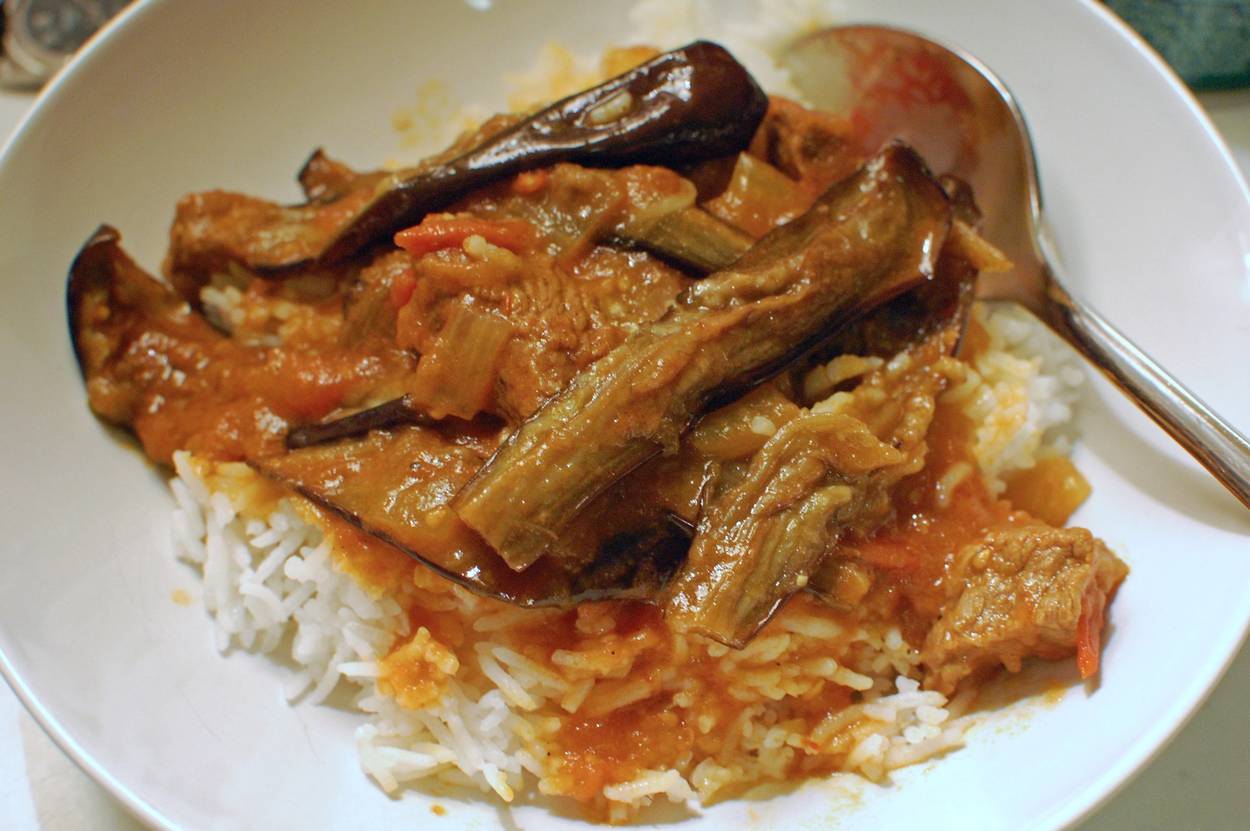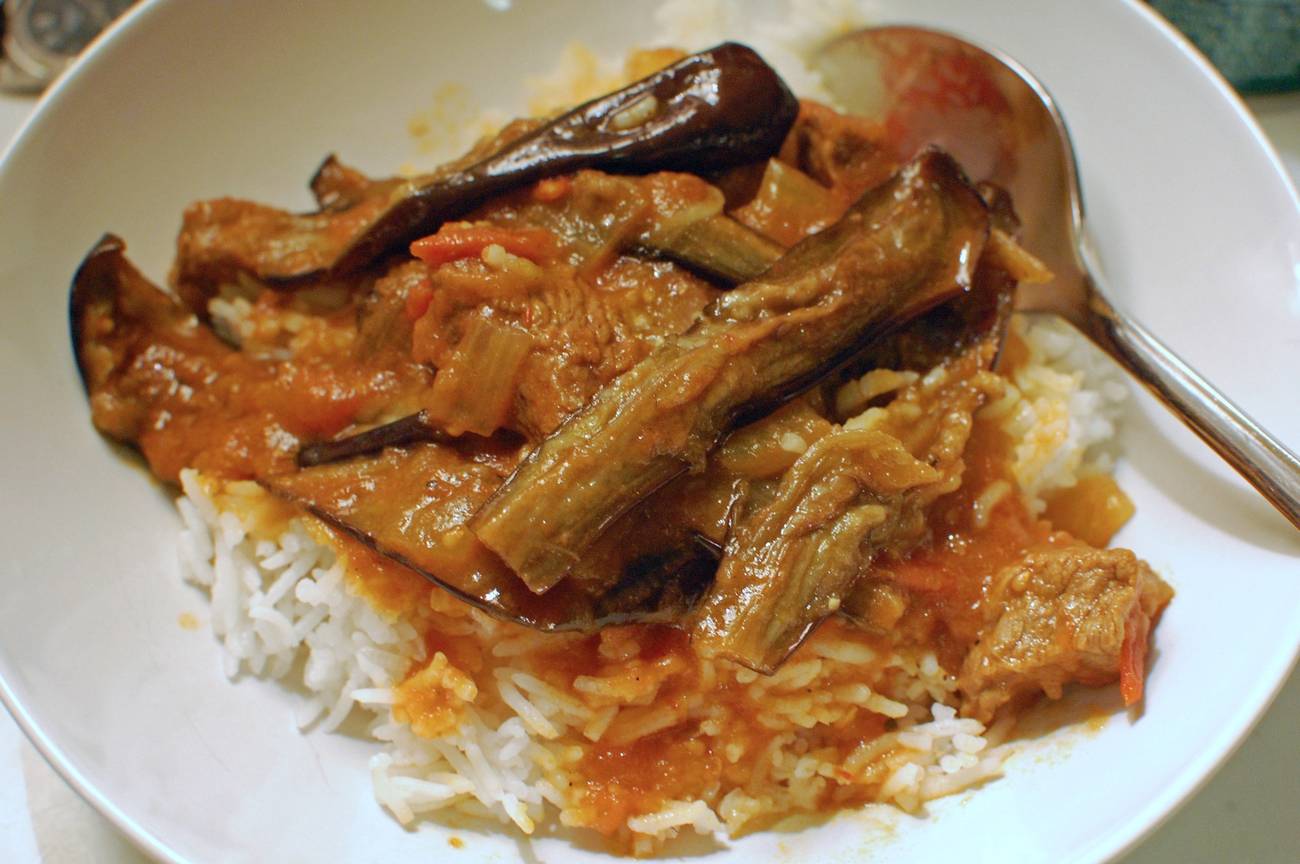The Dish That Unites Iranian Jewish Expatriates
Every Friday night, khoresh—a stew that can be made in many ways—reigns supreme on Shabbat dinner tables




For more than 30 years—from my childhood in Milan, through my family’s eventual move to New York, my marriage to a fellow Persian Jew, and the birth of my first child—one thing has remained unchanged: khoresh. This stew has reigned supreme across Friday night menus spanning decades and countries.
Khoresh holds an important place in the Iranian culinary canon and can be made in a variety of ways—albeit always served alongside white rice. My palate isn’t the only one that acknowledges the superbness of khoresh when compared to other Iranian delicacies. Almost inarguably, it has become the emblem of Iranian Jewish expatriates forced to relocate to Israel, Italy, and the United States following the 1979 Iranian revolution.
“Iranians are very into overabundance when it comes to food, so a chicken with rice and a side salad doesn’t seem like much,” said Roxanne Calderone, born and raised in New York to Iranian-born parents. “The burst of flavors that each khoresh comes with feels like a rounding out of any meal.”
Michelle Rave, a Persian Jew now living in Israel, echoed Calderone’s statement: “My mom would cringe if I would eat rice without khoresh.”
Even celebrity chef Samin Nosrat—not Jewish, but of Iranian descent—notes the supremacy of the dish within Persian cuisine. “In the winter, we ate khoresh fesenjoon, a hearty, sweet-and-sour pomegranate and walnut stew to warm us from within,” she wrote in The New York Times before listing the 10 dishes that most readily encapsulate the food genre (three of which are khoreshes). “In the summer, we’d peel eggplant for khoresh bademjoon, a bright tomato and eggplant stew made distinctly tart with lemon juice and ghooreh, or unripe grapes.”
Interestingly enough, although predominantly served on the Shabbat table in diaspora, khoresh was an everyday treat back in Iran, as ubiquitous as pasta is in Italy and burgers are in the United States.
Although not much is known about the origins of the dish, many associate the word “khoresh” with “khordan,” which, in Farsi, means “to eat.” It should come as no surprise, then, that the stew is by many considered a national food of sorts. In terms of ingredients and preparation, each type of khoresh can be associated to a specific region. Fesenjoon, for example, can be traced back to northern Iran, where walnuts and pomegranate trees are in abundance.
The various types of khoreshes—all made with chunks of meat or chicken, dried Persian limes, plus different herbs and vegetables—can be broadly split into two categories: red stews and green ones. The former grouping makes use of tomato paste as the liquid base and includes bademjoon, fesenjoon, gheymeh (also known as lapeh, it features yellow split peas), and bamieh (with okra and potatoes). Popular green khoreshes include karafs (made with celery, mint, and parsley) and what is arguably the most referenced khoresh out there: ghormeh sabzi. Boasting a vast amount of herbs, ghormeh sabzi features fresh parsley, cilantro, spinach, and fenugreek leaves, plus scallions and kidney beans.
As is the case with all sorts of culinary undertakings, each khoresh enjoys a steadfastly dedicated fan base that constantly sings the praises of its most favorite option. Arguments about the superiority of one stew over another are as defining of a Persian Shabbat table as the dishes populating the menu itself.
Of course, although immensely popular throughout generations, khoresh wasn’t the only dish that Jews fleeing the revolution took along with them. Ghabeli, a delicious rice cooked with lightly fried shaved carrots, cranberries, and chunks of meat, also claims a spot in the cuisine’s hall of fame, alongside ash reshteh—a bean and noodle soup drenched in a special kind of yogurt and a whole lot of green herbs—and a delectable Persian herb frittata called kuku sabzi.
And yet, khoresh in all its variations has become a fixture on any Persian Jewish household’s Shabbat table no matter a family’s level of religiousness, set of traditions, or current country of residence. Which begs the question: What is it that has helped the stew stand the test of time? Given the rainbow of flavors, aromas, and colors at our disposal, why is it that we constantly go back to khoresh?
Perhaps, according to Natalie Ashoory, born to an Israeli mother and Iranian father and currently living in New York, that gastronomic dominance should be attributed to Iranian culture’s overall dedication and devotion to the land. “Persian cuisine is known for its robust earthy flavors—herbaceous and citrusy—all derived from ingredients that come directly from the earth,” she said. “Anyone in Iran could source khoresh ingredients, whether living in the mountains or a metropolis. Khoresh is the most iconic dish for exactly this reason: It comes in many flavors and iterations, but it will always include tender meat, intense herbs and vegetables, and the delightful zing that comes from citrus.”
As Ashoory mentions, although the herbs and vegetables called upon change from khoresh to khoresh, the overall concept that grounds the food is the same: The stew is an amalgamation of divinely cooked beef or chicken, fried onions, salt, pepper, cinnamon, turmeric, dried lemon powder, and just enough water to hold all the additional flavors together.
That liquid quality also contributes to the khoresh’s popularity: The stew can be poured on top of just about anything. Although always served alongside white rice, it works particularly well when drenched on tahdig, the scorched, crunchy rice that forms a layer at the bottom of a cooking pot. It also adds flavor and moisture to any sort of kebob, complements a simple salad, and tastes delicious alongside a roast chicken. Khoresh in and of itself isn’t necessarily versatile, but it adds complexity and can complement virtually any other Iranian food.
That all brings us back to Calderone’s comment about well-rounded meals: Khoresh is the key to a complete Iranian feast but also a nutritious offering solo as well. Bursting with protein and fresh veggies, it happens to be a hearty food that also delivers the gastronomical requests we’ve had for the past few years. All throughout the 2010s and 2020 in particular, we’ve been searching the internet for dishes that give us ethnic flavors and unexpected ingredient usage. We’ve been asking culinary sages for recipes that we can cook in our newly rediscovered kitchens and that can still guarantee a semblance of health. In addition to being emblematic of Jewish Persian households in diaspora, might khoresh perhaps become the go-to dish in a post-pandemic world?
According to my own mother, who fled Iran for fear of persecution when she was only 14, that post-pandemic world is already behind with the times. “We’ve been cooking and enjoying khoreshes for centuries,” she said. “What took the world so long to notice it’s an exceptional dish?”
Anna Rahmanan is a New York-based writer and editor.